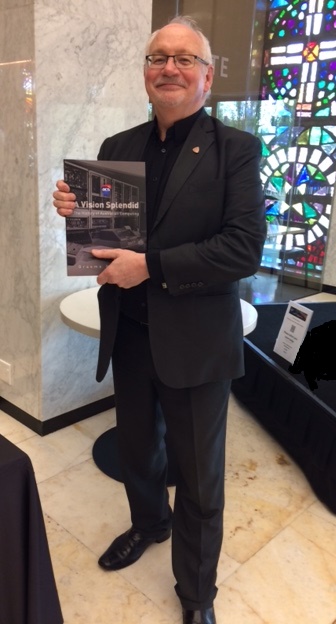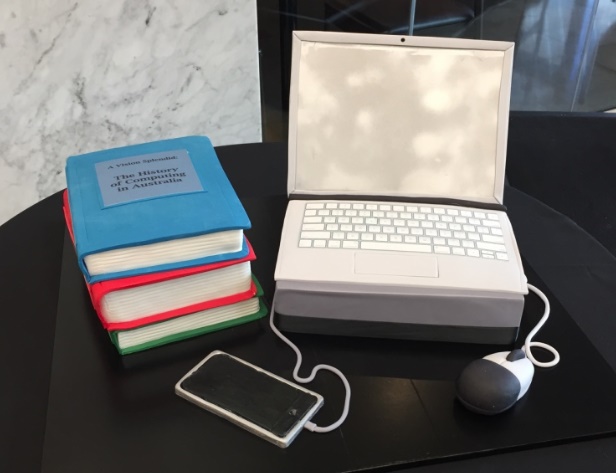The country's premier book on the history of Australian computing was launched at the National Library of Australia on Monday night.
A Vision Splendid: The History of Australian Computing by IT journalist and historian Graeme Philipson was presented in hardcopy and ebook formats to the library, and opened up discussion on the future of digital archiving.
Philipson said resources at the library contributed immensely to the creation of the book.
"Much of the source material for this book exists only in the national library.
"The fact that it's a history of computing means it's very important that [the library] gets given the book —not only in hard copy but in digital format too," he said.

Author Graeme Philipson with the book
The book, which was commissioned by the ACS Heritage Committee and sponsored by ACS, encapsulates the history of the ICT industry in Australia, from its early inception in the 1940s through to the present.
ACS President Anthony Wong congratulated Philipson on the book, saying it was important to reflect on the achievements of the trailblazers in computing, and the foundations they provided for future generations.
“This book acknowledges the significant accomplishments of the many talented and visionary Australians who played critical roles in the global developments of computers.
"At the heart of the project is the story of the computing profession in Australia, and the many talented and dedicated people who have been a part of this history.
"It is not just a history of ACS, but the history of the profession and the evolution of the ICT industry in Australia," he said.
Wong also acknowledged the work and contributions of ACS and Heritage Committee members, including Jane Bennett, daughter of ACS founder Professor John Makepeace Bennett, all without whom he said the book would not have been possible.
Philipson said one of the most outstanding and important parts of the book was featuring Trevor Pearcey's contribution to ICT. Pearcey was an industry pioneer who led the team building one of the world's first digital computers, CSIRAC.
"I don't think it's just fully appreciated what a remarkable job [Pearcey] did designing and building that computer in Australia with virtually no help and very little funding so early in the history of computing in the late 1940s.
"There's a dozen stories in the book of truly remarkable people," he said.
These included pioneers such as Bennett, and Dr Peter Thorne, an eminent engineer who also worked on CSIRAC.
.jpg)
Kathryn Ross, ACS CEO Andrew Johnson, ACS President Anthony Wong, Chair of ACS Heritage Committee Michael Hawkins, Graeme Philipson cutting the cake
ACS Heritage Committee Chair Michael Hawkins said the book was a valuable asset that paved the way to developing ACS' virtual museum of the ICT industry.
"The idea of the virtual museum is to capture artefacts and stories that didn't make it into the book and put them into an online environment, so anyone who's searching can find photos, videos and oral histories.
"It's lot easier to curate and doesn't cost money to store anywhere, so that if these things do disappear over time, at least we've captured them for the future.”
Hawkins also said part of curating the virtual museum would be asking ACS members to record their own stories of the beginning of their IT careers.
Given the large volume of information existing on the topic, with much of it being undocumented, Hawkins said Philipson had done a remarkable job of pulling it all together in just over a year.
"We always knew [the book] was going to be as good as we thought it would turn out, and to have Graeme tie all the information into something that's very readable was great," he said.
Despite it being well received, Philipson said he felt the book omitted recognition of prominent people and companies.
"The book's got shortcomings which will be ironed out in later editions, but for the first time we have a definitive history of computing," he said.
Thanking both Wong and ACS Heritage Committee Chair Michael Hawkins, Philipson said it was nevertheless a wonderful feeling to have it completed.
"It's just a massive relief in many ways to get it done, but it was a fabulous thing to do.
"I enjoyed it immensely, and it was hard work at times but very professionally rewarding," he said.
The event concluded with the cutting of cakes moulded to look like computing books and vintage computing software, followed by drinks and canapes.
The book will be available online as a PDF download from acs.org.au on 3 November 2017. For a hardback version, please email [email protected] for details.

The glorious cake!




.jpg)




